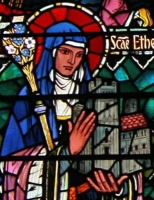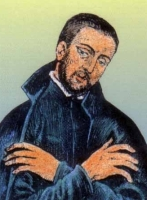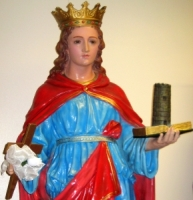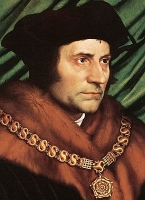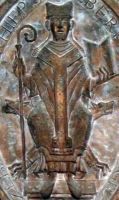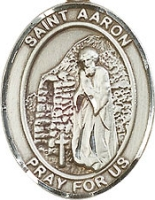Saint Joseph Cafasso
தூய ஜோசப் கபோசோ (ஜூன் 23)
இன்று நாம் நினைவுகூரும் ஜோசப் கபோசா 1811 ஆம் ஆண்டு, ஜனவரி திங்கள் 15 ஆம் நாள், இத்தாலியில் உள்ள காஸ்தல்நோவா என்னும் இடத்தில் பிறந்தார். இவருடைய குடும்பம் ஒரு விவசாயக் குடும்பம். ஆனால், பக்தியில் சிறந்து விளங்கிய குடும்பம்.
ஜோசப் கபோசா பெற்றோரிடமிருந்து கற்ற பக்தி நெறியில் நாளொரு மேனியும் பொழுதொரு வண்ணமுமாய் வளர்ந்து வந்தார். சிறுவயதிலே கடுமையான ஒறுத்தல் முயற்சிகளை மேற்கொண்டு வந்தார். அதே நேரத்தில் அன்னை மரியாவிடம் மிகுந்த பக்திகொண்டு வளர்ந்து வந்தார். தன் மகன் இப்படி பக்திநெறியில் மேலோங்கி வளர்வதைக் கண்ட ஜோசப் கபோசாவின் தாயார் அவரைக் குருமடத்திற்கு அனுப்பிவைத்தார். அவரும் குருமடத்திற்குச் சென்று நன்றாகப் படித்து, தன்னுடைய 22 வயதிலே குருவாக அருட்பொழிவு செய்யப்பட்டார்.
குருவாக மாறிய பின்பு தூரின் நகரில் இருந்த ஒரு துறவு மடத்தில் அறநெறி ஆசிரியராக குருமாணவர்களுக்கு பாடம் நடத்தத் தொடங்கினார். குருமாணவர்கள் இவருடைய பாடவேளைக்காக மிகவும் தவமிருந்து கிடந்தார்கள். அந்தளவுக்கு இவர் மாணவர்களுக்கு பாடங்களை மிக எளிதாகச் சொல்லிக் கொடுத்தார். இவர் பாடங்களைச் சொல்லிக்கொடுத்ததை விடவும் இவருடைய வாழ்வு எடுத்துக்காட்டாக இருந்தது. அதனால் பலர் இவரை ஆன்ம குருவாக எடுத்துக்கொண்டு ஆன்மீகத்தில் வளர்ந்து வந்தார்கள். அப்படி இவரைத் தன்னுடைய ஆன்மீக குருவாக வாழ்வில் உயர்ந்த இடத்தை அடைந்தவர் ‘இளைஞர்களின் பாதுகாவலராக’ அறியப்படுகின்ற தொன் போஸ்கோ ஆவார்.
ஜோசப் கபோசா ஒப்புரவு அருட்சாதனத்தை வழங்குவதில் வல்லவராக விளங்கினார். எந்தளவுக்கு என்றால், இவரிடத்தில் பாவ மன்னிப்புக் கேட்க ஆயர்கள், கர்தினால்கள், குருக்கள் என பலரும் வந்தனர். இவரும் அவர்களுக்கு நல்லமுறையில் ஒப்புரவு அருளடையாளத்தை வழங்கி, ஆன்மீக வாழ்வில் அவர்களைக் கரை சேர்த்தார். ‘ஏழைகளே நீங்கள் பேறுபெற்றவர்கள்’ என்று சொன்ன இயேசுவின் வாக்குகளை தன்னுடைய வேதவாக்காக எடுத்துக்கொண்ட இவர் ஏழைகளுக்காக தன்னுடைய உடைமைகள் அனைத்தையும் விற்றுக் கொடுத்தார். அவர்களுடைய வாழ்வு வளம் தன்னால் முடிந்ததை எல்லாம் செய்தார்.
இப்படி பல்வேறு விதமான ஆலோசனைகளை வழங்கி, அவர்கள் மனந்திரும்பி வாழ்வதற்குப் பாடுபட்டார். இதற்கிடையில் இவர் தான் இருந்த துறவுமடத்தின் அதிபராகவும் உயர்ந்தார். இப்படி ஓர் ஆசிரியராகவும் பலருக்கு ஆன்ம குருவாகவும் சிறைக் கைதிகளுக்கு ஒரு நல்ல நண்பனாகவும் விளங்கிய ஜோசப் கபோசா, 1860 ஆம் ஆண்டு இறையடி சேர்ந்தார். இவருக்கு 1947 ஆம் ஆண்டு, திருத்தந்தை பனிரெண்டாம் பத்திநாதரால் புனிதர் பட்டம் கொடுக்கப்பட்டது.
Also known as
• Giuseppe Cafasso
• Priest of the Gallows
Profile
Born with a deformed spine, and into a wealthy peasant family; he was short in stature and crippled throughout his life. Ordained in 1833. Professor of moral theology at the ecclesiastical college at Turin in 1836. Superior of the college from 1846 to 1860. Retreat house director. Pastor of Saint Francis Church in 1848. Renowned confessor. Promoted devotion to the Blessed Sacrament. Friend of and advisor to Saint John Bosco, having first met him when Joseph was 12 years old; Saint John wrote a biography of Saint Joseph. Uncle of Blessed Joseph Allamano. Founded religious fellowships.
Worked to reform prisons and prisoners, and to improve prison conditions in Turin. Ministered to condemned prisoners, winning converts. Once escorted 60 newly converted condemned to the gallows. Since many of the prisoners were hanged immediately after confessing and receiving absolution, Joseph referred to them as "hanged saints".
Born
15 January 1811 at Castelnuovo d'Asti, Italy
Died
• 23 June 1860 at Turin, Italy of pneumonia, a stomach hemorrhage, and complications of his congenital medical problems
• his will bequeathed everything to aid the ministry of Saint Joseph Benedict Cottolengo • Saint John Bosco preached the funeral Mass homily
Canonized
22 June 1947 by Pope Pius XII
Saint Etheldreda
புனிதர் எத்தெல்டிரெடா
அரசி/ இளவரசி/ மடாதிபதி:
பிறப்பு: கி.பி. 636
எக்ஸ்னிங், ஸஃபோல்க்
இறப்பு: ஜூன் 23, 679
எலி, கேம்ப்ரிட்ஜ்ஷைர்
ஏற்கும் சமயம்:
ரோமன் கத்தோலிக்க திருச்சபை
கிழக்கு மரபுவழி திருச்சபை
ஆங்கிலிகன் சமூகம்
முக்கிய திருத்தலம்:
புனிதர் எத்தெல்டிரெடா ஆலயம், எளி பிளேஸ், ஹோல்போர்ன், லண்டன்; முன்பு எளி ஆலயம் (தற்போது அழிந்துவிட்டது)
பாதுகாவல்: தொண்டை நோய்கள்
நினைவுத் திருநாள்: ஜூன் 23
புனிதர் எத்தெல்டிரெடா, ஓர் அரசர் குடும்பத்தில் மகளாக பிறந்தவர். இவர் ஒரு “கிழக்கு ஆங்கிலியன் இளவரசியும்” (East Anglian Princess), “ஃபின்லாந்து” மற்றும் “நார்தும்ப்ரியன்” அரசியும் (Fenland and Northumbrian Queen), “எளி” என்ற இடத்திலுள்ள துறவு மடத்தின் (Abbess of Ely) மடாதிபதியும், “ஆங்கிலோ-சாக்சன்” (Anglo-Saxon Saint) புனிதருமாவார்.
“கிழக்கு ஆங்கில்ஸ்” (East Anglia) நாட்டின் அரசனான “அன்னா’வுக்கு” (Anna of East Anglia) பிறந்த நான்கு புனிதர்களான பெண்களில் ஒருவர்தான் எத்தெல்டிரெடா. இந்த சகோதரிகள் நால்வருமே இவ்வுலக சுக வாழ்வினை துறந்து துறவறம் பெற்றவர்களேயாவர்.
எத்தெல்டிரெடா, கி.பி. 652ம் ஆண்டு, தமது பதினாறாவது வயதிலேயே “தெற்கு ஜிர்வ்” (South Gyrwe) நாட்டின் இளவரசனான “டோன்ட்பெர்க்ட்” (Tondberct) என்பவரை முதல் திருமணம் செய்துகொண்டார். தாம் ஏற்கனவே தமது திருமணத்தின் முன்பே கன்னிமை காப்பதாக இறைவனிடம் எடுத்துக்கொண்ட பிரமாணிக்கத்தின்படி, தன் கணவன் தம்மை நிரந்தரமாக கன்னித்தன்மையுடன் ஏற்றுக்கொள்வதற்கு இணங்கச் செய்தார். திருமணமான மூன்றே வருடத்தில், கி.பி. 655ம் ஆண்டு, அவரது கணவர் “டோன்ட்பெர்க்ட்” (Tondberct) இறந்து போனார். தமது கணவர் தமக்கு பரிசாக தந்த “எலி” (Isle of Ely) எனும் வரலாற்றுப் பிராந்தியத்திற்குச் சென்றார்.
அதன்பின்னர் தொடர்ச்சியாக, கி.பி. 660ம் ஆண்டு, அவர் “எக்ஃபிரித்” (Ecgfrith of Northumbria) என்பவரை அரசியல் காரணங்களுக்காக மறுமணம் செய்துகொண்டார். கணவர் அரியணை எரிய சிறிது காலத்திலேயே, கி.பி. 670ம் ஆண்டு, எத்தெல்டிரெடா துறவறம் பெற்றார். எத்தெல்டிரெடாவின் இந்த நடவடிக்கை, அவரது கணவர் “எக்ஃபிரித்” மற்றும் “யோர்க்” மறைமாவட்ட ஆயர் (Bishop of York) “வில்ஃபிரிட்” (Wilfrid) ஆகியோரிடையேயான நீண்ட கால சண்டைக்கு வழி வகுத்தது.
ஆரம்பத்தில், எத்தெல்டிரெடா கன்னியாகவே வாழ சம்மதம் தெரிவித்திருந்த “எக்ஃபிரித்”, 672ம் ஆண்டு, தங்களது திருமணத்தை முறித்துக்கொள்ள விரும்பினார். அரசி நம்பவேண்டும் என்பதற்காக, வில்ஃபிரெட்டுக்கு லஞ்சம் கொடுத்து தமது செல்வாக்கை உபயோகிக்க முயற்சித்தார். இந்த தந்திரோபாயம் தோல்வியுற்றதும், மன்னர் தனது ராணியை வலுக்கட்டாயமாக கைப்பற்ற முயன்றார். எத்தெல்டிரெடா திரும்ப இரண்டு விசுவாசமுள்ள அருட்சகோதரியருடன் “எளி” (Ely) பறந்தார். தாம் கைப்பற்றப்படுவதை தவிர்க்க முடிந்தது. சிறிது காலத்தின் பின்னர் “எயோர்மென்பர்க்” (Eormenburg) என்ற பெண்ணை மறுமணம் செய்துகொண்ட “எக்ஃபிரித்” (Ecgfrith) கி.பி. 678ம் ஆண்டு, ஆயர் வில்ஃபிரிடை தமது நாட்டை விட்டு நாடுகடத்தினான். கி.பி. 673ம் ஆண்டு, எத்தெல்டிரெடா “எளி” (Ely) தீவில் ஒரு “இரட்டை துறவு மடம்” (Double Monastery) நிறுவினார். பிற்காலத்தில், 870ம் ஆண்டு, இவ்விரட்டை மடம் “டேனிஷ்” (Danish) எனும் மன்னனின் முற்றுகையின்போது முற்றிலும் தகர்க்கப்பட்டது.
Also known as
Æthelthryth, Athelthryth, Audrey, Edeltrude, Edilthride, Ediltrudis, Ethelreda, Etheldreda
Profile
Sister of Saint Jurmin. Relative of King Anna of East Anglia, England. Princess. Widowed after three years marriage; rumor had it that the marriage was never consumated as Etheldrda had taken a vow of perpetual virginity. She married again for political reasons. Her new husband knew of her vow, but grew tired of living as brother and sister, and began to make advances on her; she refused him. He tried to bribe the local bishop, Saint Wilfrid of York, to release her from her vow; Wilfrid refused, and instead helped Audrey escape to a promontory called Colbert's Head. A high tide then came in - and stayed high for seven days; it kept her separated from her husband and was considered divine intervention. The young man gave up; the marriage was annulled, and Audrey took the veil. She spent a year with her neice, Saint Ebbe the Elder. Founded the great abbey of Ely, where she lived an austere life.
Etheldreda died of an enormous and unsightly tumor on her neck. She gratefully accepted this as Divine retribution for all the necklaces she had worn in her early years.
In the Middle Ages, a festival called Saint Audrey's Fair, was held at Ely on her feast day. The exceptional shodiness of the merchandise, especially the neckerchiefs, contributed to the English language the word tawdry, a corruption of Saint Audrey.
Born
c.636
Died
• 23 June 679 of natural causes
• body re-interred in 694; found incorrupt
• body re-interred in the Cathedral at Ely in 1106; found incorrupt
Blessed Mary of Oignies
Also known as
Marie d'Oignies
Profile
Born wealthy. From her early youth Mary felt called to the religious life, but she entered into an arranged marriage at age 14. She convinced her husband to live chastely, and to turn their home into a leper hospice. Mary gave away as much of her fortune to the poor as she could, and spent her days caring for lepers. She had a great devotion to Saint John the Evangelist, and a high regard for her contemporary, Christina the Astonishing. Later in life, she moved into a hermit's cell near the Augustinian house at Oignies, France and spent the rest of her life there, praying for souls in Purgatory, and giving advice to would-be spiritual students. Noted for visions, especially of Saint John and her guardian angel, ecstacies, prophecies, and psychic gifts; she ate no meat, dressed exclusively in white, may have been a stigmatist, and reported cut off pieces of her flesh to rid herself of desire for the world.
Born
1167 at Nivelles, diocese of Liege, Belgium
Died
• 23 June 1213 of natural causes
• buried at Oignies, France
• relics transferred to a silver reliquary in the church of Our Lady in Oignies in 1609
• relics transferred to the church of Saint Nicholas at Nivelle, Belgium in 1817
Saint Thomas Garnet
Additional Memorial
• 25 October as one of the Forty Martyrs of England and Wales
• 1 December as one of the Martyrs of Oxford University
Profile
Son of Richard Garnet, an Oxford don. Nephew of Henry Garnet, superior of all Jesuits in England, and in charge of the network of covert priests working among the Catholics who had refused to take the oath of Supremacy. Court page to the Count of Arundel as a boy. Because Catholic colleges had been turned over to aggressive Protestants, young Thomas went to the continent in 1593 to attend the newly opened Jesuit college at Saint Omer in the Low Countries. He studied for four years at the college of Saint Alban at Valladolid, Spain where he was ordained. Joined the Jesuits in 1604, but before he could begin his novitiate he was arrested for priesthood and lodged in the Tower of London. Exiled from England in 1606. He returned soon after to minister to covert Catholics, and worked near Warwickshire for six years, but his ministry ended in arrest during the round-up following to the discovery of the Gunpowder Plot. A plot was hatched to break Thomas out of jail, but he wrote his superior asking that the plotters not try. One of the Forty Martyrs of England and Wales.
Born
1574 at Southwark, England
Died
hanged, drawn, and quartered on 23 June 1608 at Tyburn, London, England
Canonized
25 October 1970 by Pope Paul VI
Saint Agrippina of Rome
Also known as
Agrippina of Mineo
Profile
Born to the imperial Roman nobility. Consecrated virgin, the closest thing at that time to a nun. Tortured and martyred during the persecutions of Valerian.
Born
imperial Roman citizen
Died
• beheaded or scourged to death (records vary) c.262 in Rome, Italy
• body taken to Mineo, Sicily by three women
• her tomb became known as a place of cures and miracles which led to her patronage against several things
• some relics now in Constantinople
Blessed Ioan Suciu
Profile
Born into a family of Greek-Catholic priests. Studied at Sant’Atanasio and the Pontificium Institutum Internationale Angelicum in Rome, Italy. Ordained a priest in the Romanian Greek-Catholic Rite on 29 November 1931, and earned a doctorate in theology. Chosen auxiliary bishop of Oradea Mare {Gran Varadino}, Romania and Titular Bishop of Moglaena on 25 May 1940. Chosen Apostolic Administrator of Fagaras si Alba Iulia, Romania in 1942. Arrested in 1948 by Communist authorities for his involvement in Christianity, he was imprisoned until his death 5 years later. Martyr.
Born
4 December 1907 in Blaj, Alba, Romania
Died
• 23 June 1953 in Sighetu Marmatiei, Maramures, Romania
• buried in a mass grave in within the prison, his body has never been recovered or identified
Beatified
2 June 2019 by Pope Francis
Blessed Lanfranco Beccari
Profile
Born to the Italian nobility. Chosen bishop of Pavia, Italy by Pope Alexander III in 1159. Known as a pious and charitable shepherd of his people. Had to fight civil authorities who wanted to seize Church property, and worked to recover property that had already been seized. When the civil authorities exiled him, he was restored to his diocese through the intervention of Pope Clement III. The endless wrangling and politics wore him down, and he eventually retired to spend his final years at the Vallombrosan monastery of the Holy Sepulchre near Pavia.
Born
c.1124 at Gropello, Pavia, Italy
Died
23 June 1198 at the Vallombrosan monastery of the Holy Sepulchre near Pavia, Italy of natural causes
Saint Zeno of Philadelphia
Profile
A wealthy noble. Soldier in the imperial Roman army. Seeing other Christians being martyred, he was led to become open with his own faith. He freed his slaves, gave away his wealth and possessions, and proclaimed himself a Christian before the governor; he was immediately imprisoned and tortured. Martyred in the persecutions of Diocletian.
Born
3rd century in Philadelphia in Arabia near the Dead Sea (probably refers to Rabbath-Ammon east of Palestine, the modern Amman, Jordan)
Died
beheaded in 304 in Philadelphia in Arabia near the Dead Sea (probably refers to Rabbath-Ammon east of Palestine, the modern Amman, Jordan)
Saint Lietbert of Cambrai
Also known as
Libert, Liberto, Liebert
Profile
Born to the aristocracy. Archdeacon of Cambrai, France. Bishop of Cambrai in 1051. Pilgrim to the Holy Lands in 1054. Noted for the austerity of his life, and his determination in the face of persecution of the Church and the endless political power struggles of the time.
Born
Brabant, Belgium
Died
• 22 June 1071 of natural causes
• buried on 23 June in the Abbey of the Holy Sepulchre
Saint Zenas of Philadelphia
Also known as
Zena
Profile
Former slave of Saint Zeno. After being freed, he stayed with Zeno as a servant, and became public about his Christianity. Imprisoned, tortured and martyred in the persecutions of Diocletian.
Died
beheaded in 304 in Philadelphia in Arabia near the Dead Sea (probably refers to Rabbath-Ammon east of Palestine, the modern Amman, Jordan)
Blessed Peter of Juilly
Also known as
Peter of Jully
Profile
Benedictine monk. Noted preacher. Friend of Saint Stephen Harding, and worked with him at the monastery in Molesme. Chaplain, rector and confessor to the convent of Juilly les Nonnais, France where he worked with Saint Humbeline. Miracle worker.
Born
England
Died
1136 of natural causes
Blessed Frances Martel
Also known as
Francesca
Profile
Mercedarian sister. Founded the monastery of the Assumption in Seville, Spain. Known for her personal piety and deep prayer life.
Died
buried in the church of the monastery of the Assumption in Seville, Spain
Saint James of Toul
Profile
Born to the Gallic nobility; brother of Saint Liliosa of Toul. Benedictine monk at Hornbach, diocese of Metz, France. Bishop of Toul, France in 756. Great benefactor of the Benedictines.
Born
at Berrigny, Haute Marne (in modern France)
Died
769 of natural causes at the tomb of Saint Benignus in Dijon, France
Saint Hidulphus of Hainault
Also known as
• Hidulphus of Lobbes
• Hidulf, Hydulfus
Profile
Count of Hainault in modern Belgium. Courtier at the royal palace of Austrasia. Married to Saint Agia. Helped found Lobbes Abbey which, with Agia's blessing, he entered as a Benedictine monk.
Died
c.707
Saint John of Rome
Profile
Priest. Martyred during the persecutions of Julian the Apostate.
Born
at Rome, Italy
Died
• beheaded in 362 in Rome, Italy
• a head at the church of San Silvestro in Capite, Rome, identified as Saint John the Baptist, was probably this John instead
Blessed Thomas Corsini of Orvieto
Profile
Member of the Servites. Served his house as a beggar. Visionary.
Born
c.1300 in Orvieto, Italy
Died
1343 in Orvieto, Italy of natural causes
Beatified
10 December 1768 by Pope Clement XIII (cultus confirmation)
Saint Bilio of Vannes
Also known as
Bili
Profile
Bishop of Vannes, Brittany (in modern France). Murdered by invading Normans. Martyr.
Died
• c.914 in Vannes, Brittany (in modern France)
• buried at the chapel in Plandren, France that he had built
Blessed Francis O'Sullivan
Profile
Franciscan Friars Minor priest. One of the Irish Martyrs.
Born
Irish
Died
23 June 1653 on Scarrrif Island, Kerry, Ireland
Beatified
27 September 1992 by Pope John Paul II in Rome, Italy
Saint Liliosa of Toul
Profile
Born to the Gallic nobility, the sister of Saint Jacob of Toul. Gave the country estate of Bretancour to the monks of the Saint-Bénigne to build a church.
Born
8th century Gaul (in modern France)
Blessed Walhere of Dinant
Profile
Priest in Belgium. Murdered for his righteousness and venerated as a martyr.
Died
• 1199 in Onhaye, Brabant (in modern Belgium)
• relics enshrined in Dinant, Belgium
Saint Moeliai of Nendrum
Also known as
Moelray, Melray, Mochaoi
Profile
Baptised by Saint Patrick. Monk. Abbot of Nendrum Monastery.
Born
Ireland
Died
c.493 of natural causes
Saint Felix of Sutri
Profile
Priest in Sutri, Tuscany, Italy. Martyred in the persecutions of Valerian and Gallienus.
Died
scourged to death in 257
Blessed Lupo de Paredes
Profile
Joined the Mercedarians at age 34, and served for the next 80 (!) years at the convent of Santa Maria in Logrono, Spain.
Blessed Félix of Cîteaux
Profile
No information has survived.
Died
1113 of natural causes
Martyrs of Ancyra
Profile
A family of converts who were arrested, tortured, and sent in chains to Ancyra, Galatia (modern Ankara, Turkey) where he was tortured more by order of governor Agrippinus during the persecutions of Diocletian. Martyr. They were - Eustochius, Gaius, Lollia, Probus, Urban
Died
roasted over a fire and finally beheaded c.300 in Ancyra, Galatia (modern Ankara, Turkey)
Martyrs of Nicomedia
Profile
During the persecutions of Diocletian, many Christians fled their homes to live in caves in the area of Nicomedia. In 303 troops descended on the area, systematically hunted them down, and murdered all they could find.
Eldrude of Brittany
Feast Day:
The feast day of Saint Eldrude of Brittany is celebrated on June 23rd. This information is consistent across several sources focused on saint feast days
Details about Saint Eldrude's life are scarce.
She is recognized as a saint, particularly within the Catholic tradition.
Her association with Brittany suggests a connection to the region in northwestern France.
Gerhard of Clairfontaine
Lived in the late 11th or early 12th century, likely in Lorraine, France.
Received education at the renowned cathedral school in Laon, known for its theologians Anselm and Radulf.
Religious Life:
Inspired by Norbert of Xanten, founder of the Premonstratensians, Gerhard joined the order.
Initially resided at the order's mother house in Prémontré.
Struggled with self-discipline, particularly overeating. After correction, he repented and devoted himself to prayer and fasting.
Abbacy:
In 1131, Gerhard became the first abbot of the newly established Saint-Nicolas Abbey in Clairfontaine.
Led his fellow Premonstratensian canons at Clairfontaine until his death in 1150.
Veneration:
Revered as "Blessed Gerhard" by the Premonstratensians.
Feast day celebrated on June 23rd.
Maria Raffaella Santina Cimatti
Maria Raffaella Santina Cimatti, also known as Santina Cimatti, was a blessed woman in the Catholic Church and a member of the Hospital Sisters of Mercy. Here's what we know about her:
Life and Background:
Born in 1861 in Celle di Faenza, Italy, to a humble family. Her father was a farm laborer and her mother a weaver.
Had several siblings, but three died in childhood.
Began working at a young age to help support her family.
Religious Calling:
Devoted to her faith and felt a calling to religious life.
Entered the Congregation of Hospital Sisters of Mercy.
Service and Legacy:
Dedicated her life to serving the sick and those in need.
Known for her compassion, humility, and strong work ethic.
Beatified (declared "Blessed") by the Catholic Church, though the exact date is not widely available in English sources.
Veneration:
Celebrated as Blessed Maria Raffaella Cimatti by the Catholic Church.
Her feast day is unknown in English sources, but you might find it on Italian Catholic websites.
Morónóg of Inishloe
Lived: Believed to be from the 5th century, possibly Ireland.
Veneration: Considered a saint by the Catholic Church.
Title: Known as "Saint Morónóg" or "The Holy Morónóg of Inishloe".
Location: Associated with Inishloe (Inis Luaidhe), an island in County Clare, Ireland. There's a possibility he had a church there.
Connection to Saint Senan: Historical accounts mention him attending the transportation of Saint Senan's remains to Scattery Island.
Peter James of Pesaro
Blessed Peter James of Pesaro is celebrated on June 23rd by the Augustinian Order
Documents show him working as a calligrapher in 1472.
By November of the same year, he was the Director of Students at the Augustinian house of studies in Perugia. This indicates a strong intellect and academic background.
He earned the degree of Master of Theology in 1497.
Unfortunately, the exact date of his death is unknown, but it's believed to be around 1496.


